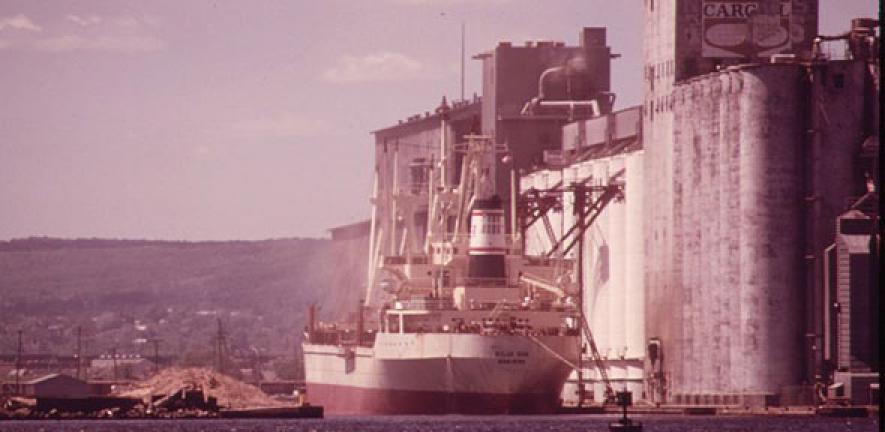
Seventy five years ago, the publication of John Steinbeck's novel The Grapes of Wrath shocked the world with its description of starvation in the midst of plenty. PhD candidate Rasheed Saleuddin is re-evaluating established views of the causes of the Great Depression and argues that there are lessons to be learned today.
Seventy five years ago, the publication of John Steinbeck's novel The Grapes of Wrath shocked the world with its description of starvation in the midst of plenty. PhD candidate Rasheed Saleuddin is re-evaluating established views of the causes of the Great Depression and argues that there are lessons to be learned today.
Think of it, the food of hundreds and hundreds of thousands of people just at the mercy of a few men down there on the Board of Trade. They make the price. They say just how much the peasant shall pay for his loaf of bread. If he can’t pay the price, he simply starves.
Frank Norris writing in The Pit (published 1903)
It took an estimated 2.3 billion metric tonnes of grain to feed the world in 2011 – that’s 6,300,000 tonnes per day. These staple foodstuffs, primarily wheat and corn, are traded on global commodities markets, and one sixth of this total is produced in the Midwest of the USA annually. Once harvested, the grain begins an often long journey, stopping first in one of the many elevators (silos) that soar above the Midwestern prairie landscape.
These vast storage facilities house the grain that keeps much of the world supplied with bread, pasta and other basics. In North America many of the tallest elevators are owned by Cargill, one of the world’s biggest private companies. Cargill traces its roots back to a single grain warehouse in 1865, and continues to dominate world markets for commodities such as wheat and cattle. Companies like Cargill are major traders in organised commodity markets in Chicago and elsewhere. On one exchange, the Chicago Board of Trade (CBOT), 349 billion bushels of corn, 115 billion bushels of wheat and 184 billion bushels of soya beans changed hands in 2010.
The power of traders on the exchanges to set prices for basic foodstuffs was established by the late 1800s. In a novel called The Pit (published in 1903), Frank Norris wrote: “Think of it, the food of hundreds and hundreds of thousands of people just at the mercy of a few men down there on the Board of Trade. They make the price. They say just how much the peasant shall pay for his loaf of bread. If he can’t pay the price, he simply starves.”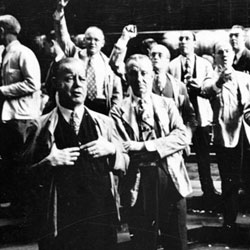
Rasheed Saleuddin, a PhD candidate in the Faculty of History, is studying the economic context in which some of the world’s most powerful trading interests emerged. He explained: “My research looks at the interaction between grain trading pioneers and monopolists such as Cargill, clubby self-regulatory agencies such as the Chicago Board of Trade, well-funded academic investigators, and bureaucrats from a newly-interventionist US Federal Government during the rapid development of grain trading markets in Chicago and elsewhere in the US Midwest during the period between the First and Second Word Wars.”
With extensive experience in trading commodities and ‘derivatives’ (securities linked to the performance of commodities) as a hedge fund manager, Saleuddin’s most recent work revisits the ways in which some of the leading economists working in the latter half of the 20th century explained the causes of the Great Depression of the 1930s. By examining the intricacies of the markets for agricultural commodities, such as wheat and corn, he has been able to critique some important evidence for one view of the causes of the Great Depression.
“I’ve been able to apply academic evidence accumulated during the interaction between interest groups such as the newly-formed US regulatory agency, the Grain Futures Administration (1922) and the Stanford Food Research Institute, funded by later US President Herbert Hoover in the same year,” he said.
“An agriculture commodity future is a contract, traded on an organised market called an exchange, whereby a specific quantity of certain subset of grades and quality of a natural raw product (such as wheat or cotton) can be contracted for at a set price in advance of its delivery. For example, a wheat elevator operator storing wheat from the most recent harvest over the winter could enter into a futures contract to sell that wheat for delivery the following May. In May, the operator could deliver the wheat to the other side of the contract, who, crucially but perhaps confusingly, would not necessarily be the original counterparty. More likely, however, both parties would close their contract out before maturity in May, and the elevator operator would make a separate agreement at that time to sell the wheat to a cash buyer.”
The exchange not only provides a place to do business but also sets the rules of engagement, one of which mandates the settlement of the profit or loss on these contracts at the end of each trading day, others of which allow for transferability and fungibility (whereby every contract is identical to every other contract) of any agreement made on the exchange.
Though of earlier origin, exchanges on which these futures could be traded became well established in the US Midwest and coastal cities by the middle of the 19th century. The earliest futures markets in the US traded agricultural products, such as wheat, cotton and maize corn. The wheat market was especially important, according to the accepted history: it allowed farmers and middlemen, who held grain stores over the winter when the trade routes were inaccessible, to set a price for their inventories in advance of their sale, reducing the risk to further drops in price.
By the interwar period, traders in these futures markets for goods such as wheat or cotton set the prices transacted between farmers and middlemen or middlemen and end-users (including flour millers) in the much larger “spot” or ”cash” markets of those commodities, where most of these agricultural products were traded for immediate delivery by truck or boatload. 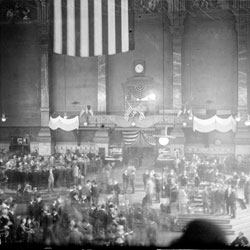
Saleuddin and his academic supervisor D’Maris Coffman are revisiting and reinterpreting the models developed by Stanford agricultural economist and statistician Holbrook Working and his contemporaries during the 1920s and 1930s. “The studies of futures markets carried out in the years between the World Wars could not be replicated in today’s markets due to the increased complexity of modern markets as well as the political difficulties in obtaining compliance from the regulated for the information required,” said Saleuddin.
However, much of the early work done by the USDA, the Federal Trade Commission, Penn, Stanford and others has been ignored by more modern economists, who are less focused on the intellectual history of the study of these markets, and less interested in the context of the data they have been analysing from the period.
When the Great Depression hit North America in late 1929, the consequences were disastrous for the farmers of the Midwest. After record harvests the previous year, and facing oversupply throughout most of the 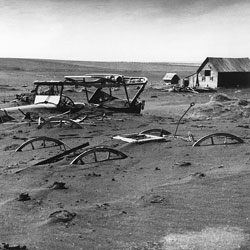 1920s, demand all of a sudden dried up for most foodstuffs, while Europe imposed quotas and embargoes and Argentina and Australia swamped the markets with their exports. Another record grain crop in 1931 was harvested with little hope for its resale, domestically or as export. The price of Chicago wheat fell hard and fast from $1.40 per bushel in July 1929 to 49 cents – a fall in value of about two-thirds in just two years.
1920s, demand all of a sudden dried up for most foodstuffs, while Europe imposed quotas and embargoes and Argentina and Australia swamped the markets with their exports. Another record grain crop in 1931 was harvested with little hope for its resale, domestically or as export. The price of Chicago wheat fell hard and fast from $1.40 per bushel in July 1929 to 49 cents – a fall in value of about two-thirds in just two years.
Immediately after this, a second disaster hit: what became known as the Dust Bowl was a severe drought across the USA that began in 1933 and severely affected the economic social and political landscape of the US, arguably to this day. Prices doubled from the depths of the original crash, rising above a dollar by mid-1934. By 1937, 21% of rural families were on emergency government relief. Almost one in ten farms changed hands in 1933, half of those voluntarily.This was the America of John Steinbeck and his epic 1939 novel The Grapes of Wrath. It was not until the advent of the Second World War, ten years after the initial stock market crash, that economic output in the US recovered its pre-1929 levels.
This devastating period of economic meltdown caused untold hardship to millions in the Western world. Explanations of its causes were hotly debated at the time and have continued as a focus for discussion among economists.The monetarists, a highly influential school of what has become orthodox economic thought, claim that the Great Depression could have largely been avoided if the US government had provided more money, usually measured as consisting of currency in circulation and bank deposits, into the financial system.
Saleuddin argues that the problem with this hypothesis is that the cost of money, as measured by the rental value of money, the interest rate, was quite low, indicating anything but a shortage. The response of most economists is to focus on the interest rate after adjusting for price changes in the economy, usually called the “real” rate of interest. Thus, the rate shown in the newspapers, usually called the “nominal” rate of interest is related to the real rate as follows: Real rate of interest = Nominal rate - inflation (or + deflation).
If deflation (a fall in the general price level) was expected in 1929-1932, then, even if the nominal rate of interest was near zero, the expected real rate of interest could have been quite high, thus providing evidence of a shortage of money during the early Depression years.
In 1987 and 1992, well-known economist James Hamilton noticed that the future price was almost always higher than the spot price during the early years of the Depression. Hamilton concluded that people expected inflation, not deflation, after the crash of 1929, and, therefore, a shortage of money is unlikely to be the sole cause, if it was a cause at all, of the Great Depression.
Saleuddin, however, suggests that Hamilton failed to understand Holbrook Working’s famous empirical observation, referred to in modern works as the “Working Curve”, that the futures price of wheat is always higher than the current price whenever there is a huge surplus of grain sitting in storage, as there was during the early years of the Great Depression. “That the spot price was below the futures price for most of the early years of the Depression tells us nothing about the expectations of economic agents during this period,” he said.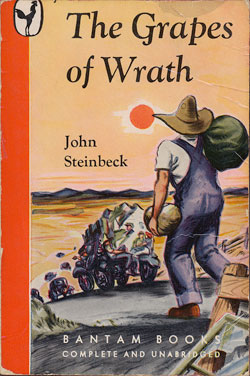
“Hamilton ignored the microstructure of the futures markets as well as the context of the times, and so reached erroneous conclusions.This has important policy implications today, especially as one the most prominent supporters of a non-monetarist explanation of the Great Depression, Ben Bernanke, until very recently sat in the most important position in the world for determining economic policy as chair of the US Federal Reserve. Additionally, Hamilton’s work was recently cited, for example, by Bank of Japan governor Haruhiko Kuroda in his defence of his current monetary policy. If Friedman and the monetarists were correct about the cause of the Great Depression, monetary policy would be the sole and prime focus of policy makers. If not, the world must turn to other solutions to close the output gap that has been caused by this most recent global financial crisis.”
The interwar period in the USA was characterised by a globalisation of agricultural commodity markets and severe dislocations, including the return to free markets after the First World War and, of course, the Great Depression of 1929-1939. The nature of the most severe crisis in over 100 years as well as an understanding of the politics and economics of contemporary (and arguably current) financial markets can only be understood though a detailed examination of archives relating to this period.
Saleuddin’s research draws on his exploration of a wide range of primary sources – political, business, media, theoretical and empirical – which together will enable him to present a better understanding of markets in general, but especially financial market and US government behaviour during the Great Depression. He said: “In this way, it may just be possible for this history to force a rethink of government policy in the regulation of financial markets as well as management of the economy in general.”
Inset images: Chicago Board of Trade traders, room in old Chicago Board of Trade building, dust bowl in Dallas (all Wikimedia Commons), The Grapes of Wrath, John Steinbeck (Flickr Creative Commons).
The text in this work is licensed under a Creative Commons Licence. If you use this content on your site please link back to this page. For image rights, please see the credits associated with each individual image.





